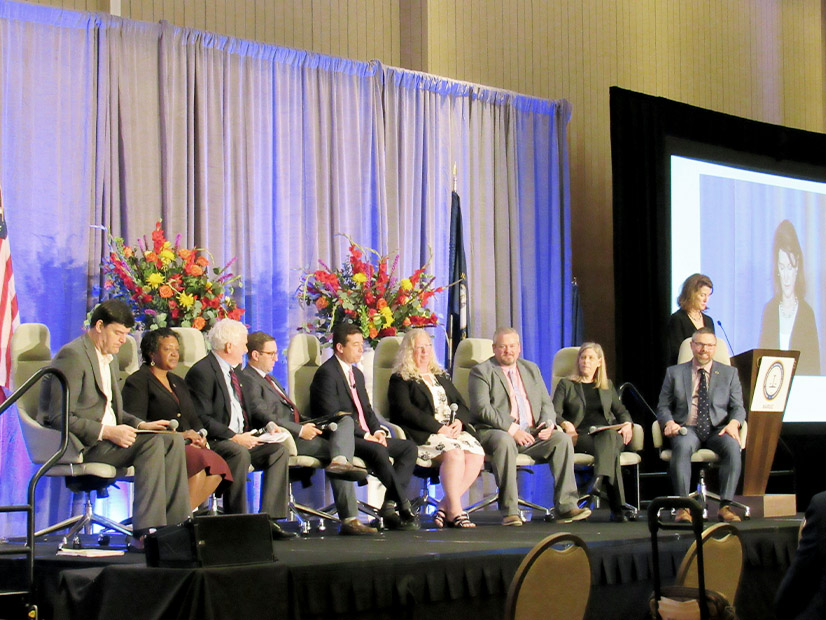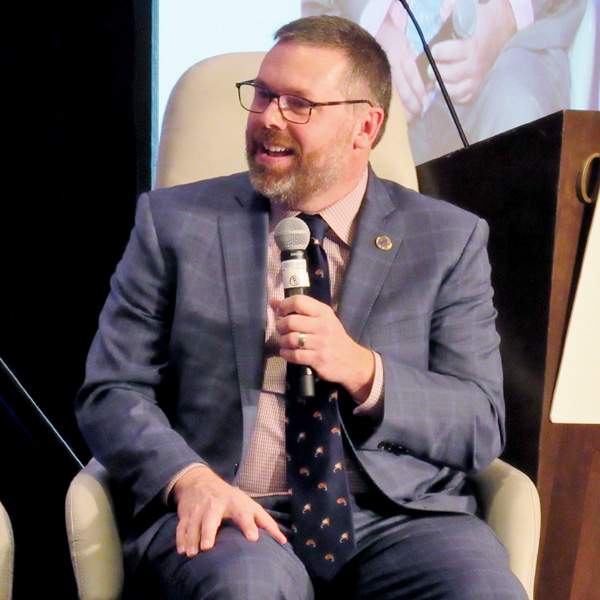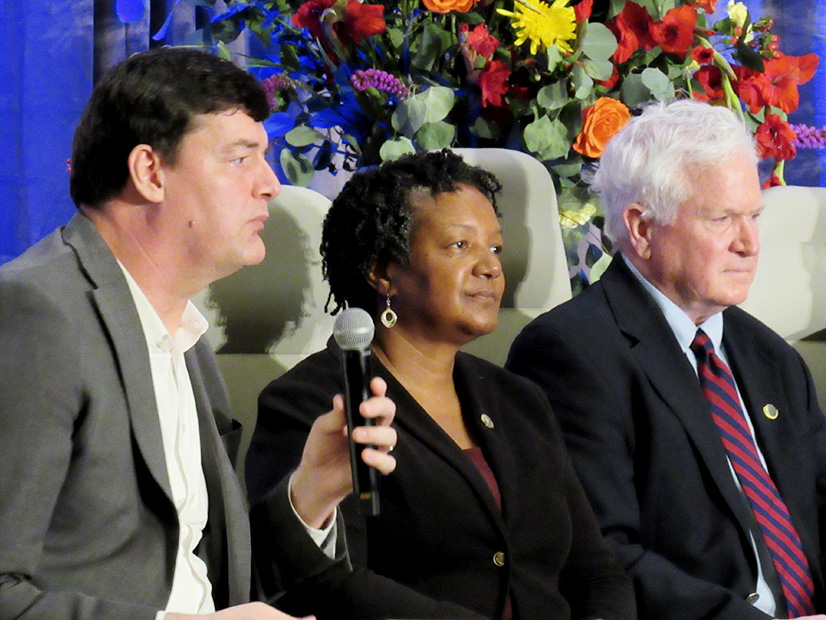
LOUISVILLE, Ky. — The Joint Federal-State Task Force on Electric Transmission convened its first meeting Wednesday, with FERC asking whether SPP’s Regional State Committee could serve as a model for increasing state involvement in cost allocation and transmission planning.
FERC Chairman Richard Glick announced the task force — which includes FERC members and 10 state regulators — in June to seek ways to accelerate transmission expansion needed to improve resilience and deliver growing volumes of renewable power (AD21-15). (See FERC Sets Federal-State Taskforce to Spur New Tx.)
The inaugural meeting came on the sidelines of the 2021 National Association of Regulatory Utility Commissioners’ Annual Meeting and Education Conference.
FERC Commissioner Mark Christie asked whether the commission, given its regulation of non-RTO utilities, requires state involvement. Referring to SPP, he observed it is “clearly one that has more state involvement than any other RTO, that’s for sure.”
The RSC, formed in 2004, comprises regulators from 11 of the SPP RTO’s 14 states. The committee provides state regulatory agency input on primarily cost-allocation matters.
“The SPP model is a good model,” said Arkansas Public Service Commission Chair Ted Thomas, who has served on both the RSC and MISO’s Organization of MISO States.
“The RSC has worked really, really well to give the states a lot of power and input over … cost allocation and resource adequacy,” agreed Andrew French, chair of the Kansas Corporation Commission.
But he also said the RSC benefits from “being pretty similarly situated states, geographically and policy-wise.” The group has been having difficulty reaching unanimity as of late, which he attributed to SPP’s push to set up a Western RTO.
“I welcome the diversity of opinion. I do wonder what the intersection of that is, where the Regional State Committee that wields that much power, and the potential for gridlock when you have really diverse states,” French said. “I love our model. … I don’t know how it deploys to other regions.”
Limits of Federal Jurisdiction
The nearly five-hour session was marked by a sense of optimism — and urgency.
State officials welcomed FERC’s outreach, with task force lead Jason Stanek, chair of the Maryland Public Service Commission, calling it historic. But he warned that the 10 state members on the panel have differing ideas on how to accomplish the transmission buildout.
“We’re not a monolith on this dais,” he told a NARUC general session that preceded the task force meeting. “We’re not trying to paper over our differences.”
 Maryland PSC Chair Jason Stanek | © RTO Insider LLC
Maryland PSC Chair Jason Stanek | © RTO Insider LLCWhether states play a formal role in transmission planning or not, the “states will be most comfortable as long as they know their policies are going to be considered in one of these transmission planning processes,” he said.
California Public Utilities Commissioner Clifford Rechtshaffen said there’s a growing recognition in the West that transmission is needed for reliability, especially as the country begins to grapple with the effects of climate change. He said California expects to import power to meet load.
“I share the views of many others that our current planning process doesn’t take into account the future resource mix,” Rechtshaffen said. He said he was “delighted that FERC was leaning into these issues in this unprecedented way.”
French said there was “a big value in getting us all in the same room.” He said Kansas is surprisingly a leading state in clean energy and stands ready to share its lessons learned, being further along in the energy transition than some states.
 Michigan PSC Chair Dan Scripps | © RTO Insider LLC
Michigan PSC Chair Dan Scripps | © RTO Insider LLCMichigan Public Service Commission Chair Dan Scripps said his state, which is limited by its peninsular geography, has been working with MISO for the past two years on how to better integrate into the system and increase its import and export capability. “Transmission can’t be the answer to every problem, but it can be the answer to some,” he said.
“We’re ready for this conversation,” Thomas said.
But FERC Commissioner James Danly sought to temper expectations.
When it comes to transmission planning, if FERC has “lofty ambitions” and “wants to implement aggressive policies” to incentivize different initiatives, it will require state cooperation, as states wield veto power for transmission projects, he said.
Scripps urged FERC to “use a scalpel and not an axe” in considering rule changes. “Things like grid-enhancing technologies, hybrid programs and particularly storage are [areas] where FERC has a unique role,” he said.
Urgency in New England
Matthew Nelson, chair of the Massachusetts Department of Public Utilities, said that although New England has built enough transmission to address its current congestion, its needs will increase because of the states’ “extremely aggressive clean energy targets.”
“We’re trying to move our transportation sector and our building sector onto the electric grid, so that we can do that with renewable energy. The status quo of where we are now won’t be acceptable with the load growth that we anticipate,” he said. “The resource that we’re really running out of in New England is time to achieve our goals.”
Vermont Public Utility Commissioner Riley Allen said his state has “tall ambitions that are frankly getter taller as we speak.” It was historically a net exporter of nuclear energy but now faces scarce supply paired with unsuitable conditions for solar generation. He said John Oliver’s segment on Sunday’s “Last Week Tonight,” which focused on the nation’s need for transmission construction, was spot on. “We have a generation pocket that needs transmission,” he said.
“I feel like I’m in two parallel universes,” Allen said, pointing to the variety of state-level and regional planning processes his state, an ISO-NE member, is party to. “On the state level, we have a robust planning framework … that actually does help us understand the cost of the renewable paths we might take and the implications for our transmission systems. It’s great, because it informs developers and others where to locate and what the costs are.”
Kansas: ‘A Microcosm’
French said his state is “on the leading edge” of renewable energy adoption and the “complicated transmission issues” that accompany the transition.
The state’s movement toward renewable resources resulted not from state environmental policies but the fact that it “sits on really optimal” low-cost renewable resources, he said. He views Kansas as a “microcosm of the entire nation” with where its resources are in relation to load centers. “We have extremely resource-rich areas in the west for wind and solar, but the load in Kansas tends to be on the far eastern side of the state and in a different pricing zone.”
Cost Allocation, Transparency
Gladys Brown Dutrieuille, chair of the Pennsylvania Public Utility Commission, said her state recognizes that its neighbors have different policies regarding renewable generation and the need for constructive discussions to find solutions.
“We understand as the Keystone State, we’re right in the middle of transmission and making sure the grid is secure and upgraded and providing the needed energy to everyone,” she said. “But it’s also making sure that it’s appropriate in terms of cost allocation and making sure the cost is not burdensome to our consumers, especially those that may not be direct beneficiaries.”

FERC Commissioner Allison Clements took up the issue of transparency in the planning process, asking whether the task force’s members shared concerns she had heard from others during the NARUC conference.
French said Kansas utilities have been responsive when the KCC inquired about their local planning efforts.
“My concern … is not so much a concern about transparency. It’s a concern of optimization,” he said. “When you create a regional plan, you may not look at the local systems. I think we should be asking ourselves, ‘Should the regions be looking at some of it a little further down on the local systems … that didn’t get brought into the RTOs?’
“Could the RTOs be identifying what meets the local needs and provides regional benefits at the same time?”
Reliability vs. State Policy
Later in the session, there was a debate between those who favor state policy goals — especially renewable targets — playing a larger role in transmission planning and those who believe it should be based on reliability and load forecasts.
“If FERC attempts to reform planning by requiring consideration of states’ perspectives and energy-related goals, I fear that it will impair the ability to get transmission built because the energy goals are the polarizing part of the conversation,” said Idaho Public Utilities Commissioner Kristine Raper. “So I’m back to reliability as the premier consideration here.”
States already have a significant say in FERC decision-making, she said.
“Adding a level of bureaucracy by … FERC mandating the states have a role in some piece of the transmission planning process would likely increase friction,” Raper said.
FERC’s Christie insisted “transmission planning should be about one thing overall and that is providing a reliable supply of power to the retail customer.”
“What if you build a public-policy project and that public policy changes the next election?” he asked. “Then you’ve got a billion-dollar project that you’ve got to pay for … [but it’s not] supported by the public policy. Whereas transmission that is meant to follow the customer, transmission that is meant to provide reliable power to load, that transmission is going to be justified always.”
FERC’s Glick said he understood that “we don’t want to plan for transmission and have it get built and then not be used and stick consumers with an enormous bill. On the other hand, I don’t think we can treat this process as an exact science because it’s not.”
There are ways to reduce risk in transmission planning through “probabilistic determinations, scenario planning and the rest,” he said.
States differ on policies, even those within an RTO such as PJM. But Glick said the discussion had focused too much on public policy. State and federal policies drive transmission planning, but so does consumer demand, he said.
“People recognize that climate change is a big issue,” Glick said. “They want to address climate change. You’re causing as much damage by not being anticipatory enough in terms of your transmission planning if you [looked forward] every 18 months or whatever the traditional planning process is. If you really didn’t look beyond that, you’d actually be in a situation where you’d be much worse off, and we need to weigh that against the risk of maybe not being 100% accurate in terms of where the states might be in five or 10 years.”
Adjourning the meeting later, Glick said, “This was fun. Let’s do it again.”
No date was announced for the next meeting.


